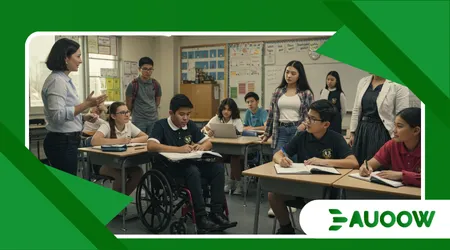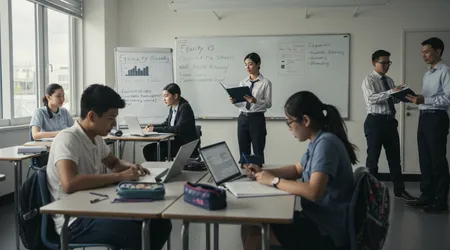Equity vs Equality in Schools: What Policies Actually Work?

The pursuit of educational excellence demands more than good intentions; it requires precise strategy. Central to this strategy is clarifying the difference between Equity vs Equality in Schools.
Many institutions proudly offer “equal” access, providing the same resources to every student. Yet, this approach often fails to close achievement gaps because students don’t start from the same place.
True, lasting inclusion requires equity, which means providing each student with the specific, tailored resources they need to reach a comparable outcome.
This article dissects the critical distinctions between these two concepts, moving beyond rhetoric to identify the policy mechanisms that drive measurable success in inclusive education.
We will explore how smart, data-driven equity policies are transforming school systems worldwide in 2025. It is a necessary conversation that determines the future quality of education for all children.
Why Is the Difference Between Equity and Equality So Important in Education?
The semantic distinction between these two terms holds massive implications for resource allocation and ultimate student outcomes. Understanding their core meaning is foundational.
What Does Equality Look Like in a Classroom Setting?
Equality means sameness. In schools, this translates to every student receiving the exact same textbook, the same number of minutes of instruction, and the same desk. It aims to treat everyone identically.
This approach is fair in theory but ignores external realities. Giving a standard textbook to a student with dyslexia and a student without, while “equal,” does not lead to equal learning. The playing field remains uneven.
Equality policies often fail marginalized students because they require everyone to overcome their unique barriers using the same, limited toolset. It assumes a uniform starting line for diverse learners.
++ Why Inclusive Education Is Key to Achieving the SDGs by 2030
How Does Equity Actually Address Student Needs?
Equity recognizes that students have different needs and backgrounds, requiring differentiated support. It means providing customized tools to achieve the same final outcome.
For the student with dyslexia, equity means providing an audio reader or specialized instructional time, not just the standard textbook. For a student facing poverty, equity might mean access to tutoring, nutritional support, or reliable technology.
Equity policies are dynamic and demand flexible resource allocation, consciously directing more support where the initial disadvantage is greatest. This targeted approach is the only way to genuinely level the educational landscape.

What Policies Successfully Bridge the Equity Gap?
Effective equity policies are not abstract; they are tangible, funded programs directly addressing systemic barriers. They focus on resources, not just access.
How Do Targeted Funding Models Prioritize Equity?
Funding is the primary lever of equity. Targeted Funding Models allocate resources based on documented student need, rather than simple enrollment counts.
Also read: Sensory Play: Enhancing Learning for Students with Special Needs
Why Does Weighted Student Funding (WSF) Work?
Weighted Student Funding (WSF) is a proven mechanism where funding follows the student, but with specific weights added for categories of disadvantage.
Students identified as low-income, English Language Learners (ELLs), or those with special needs receive significantly higher per-pupil allocations.
This means schools serving more disadvantaged populations receive more resources per student, allowing for smaller class sizes or specialized staff. The WSF model, utilized by progressive districts, directly translates the concept of equity into a functional budget.
This approach ensures that schools in socio-economically challenging neighborhoods can afford the reading specialists and social workers their students need most. The model is a direct rebuttal to the failed uniformity of pure equality funding.
Read more: From Segregation to Inclusion: How Schools Are Evolving Worldwide
What Is the Impact of Universal Access to Technology?
Digital equity is crucial in 2025. Providing every student with a device (1:1 computing) is an equality measure; providing reliable high-speed internet access at home for all low-income students is the equity measure. The latter removes the external barrier to homework completion and research.
Many successful districts now provide mobile hotspots or partner with local governments to ensure internet access. This ensures that the digital gap, a major driver of deficit learning, is finally closed outside the school walls.
How Does Staffing Policy Drive Equitable Outcomes?
The people in the school building teachers, counselors, and support staff are the frontline delivery mechanism for equity. Policies must address the human factor.
Why Is Culturally Responsive Teaching (CRT) Essential for Equity?
Culturally Responsive Teaching (CRT) is not just a feel-good measure; it is a pedagogical necessity. It requires teachers to integrate students’ cultural backgrounds, life experiences, and communication styles into the curriculum and instructional methods.
How Does Teacher Development Affect Equity?
Policies mandating deep, continuous professional development in CRT techniques lead to better engagement and reduced disciplinary action, especially for students of color. Teachers learn to see differences as assets, not deficits. This directly counteracts unconscious bias in the classroom.
Furthermore, equitable staffing policy focuses on recruiting and retaining highly experienced, specialized teachers in the highest-need schools. Offering salary incentives or student loan forgiveness for teachers in high-poverty areas is a tangible equity strategy.
What Role Do Counselors Play in Equity?
Counselors must be allocated based on the complexity of student needs, not just student count. Schools with high rates of trauma, instability, or poverty require a lower student-to-counselor ratio. Equity demands this personalized support structure.
Counselors address the non-academic barriers mental health, housing instability, or chronic absenteeism that prevent learning. Without this human infrastructure, even the best curriculum fails.
Statistic: A 2024 longitudinal study tracking US public school districts by the Council of Great City Schools found that districts implementing Weighted Student Funding models combined with targeted professional development saw an average reduction of 15% in the standardized test score gap between high- and low-income students over five years. This demonstrates the tangible power of Equity vs Equality in Schools.
Practical Application: Designing the Equitable School Ecosystem
Designing for equity requires a systemic perspective, viewing the school not as a silo but as part of a broader support ecosystem.
How Do We Measure the Success of Equity Policies?
The success of equity policies cannot be measured by inputs (dollars spent) but must be measured by outcomes. Data collection must be transparent and granular.
Moving Beyond Attendance and Grades
While attendance and grades are important, true equity policies measure graduation rates, college persistence rates, and most importantly, the reduction of exclusionary discipline rates (suspensions). If discipline rates are disproportionately high for a specific demographic, the policy is failing the equity test.
These deep metrics reveal whether the system is truly supporting vulnerable students or merely processing them. The commitment to honest, outcome-based assessment is the final, essential step in effective equity planning.
Example 1 (Equality Failure): Two neighboring schools receive exactly the same per student. School A is 90% middle-class; School B is 70% low-income and 30% ELL. School A thrives. School B’s failure to hire enough ELL specialists with that identical budget highlights the collapse of the equality model.
Example 2 (Equity Success): Following the WSF model, School B receives an effective per student due to their high-need population weights.
They hire two specialized ELL teachers and a full-time social worker, leading to improved reading scores and engagement. This demonstrates the success of targeted resource deployment based on Equity vs Equality in Schools principles.
Analogy: Equality gives everyone the same size shoe. Equity gives everyone the shoe size they actually need to run the race effectively. Why would we give a size 40 shoe to a person who wears size 36 and expect them to win?
| Policy Category | Key Strategy | Equity Outcome Measured |
| Funding | Weighted Student Formula | Reduction in per-pupil funding disparity based on need. |
| Pedagogy | Culturally Responsive Teaching (CRT) | Increased student engagement and decreased discipline disparities. |
| Support | Proportional Universalism (Targeted Counseling) | Increased graduation rates for students with identified trauma/disabilities. |
Conclusion: The Mandate for Tailored Support
The debate over Equity vs Equality in Schools is settled: only equity provides the structural solution necessary to close the achievement gap.
Equality is a low bar of identical treatment; equity is the moral and strategic imperative of providing tailored support.
Effective policies demand targeted funding, reliance on data, and a commitment to professional development that sees student diversity as an asset.
By implementing Weighted Student Funding and investing in human infrastructure like counselors and specialized teachers, schools can move beyond rhetoric to deliver genuine, transformative outcomes for every child.
Which specific equity policy funding or staffing do you believe has the largest impact on student success? Share your thoughts and institutional experiences with equity models in the comments below!
Frequently Asked Questions (FAQ)
Q: What is the difference between equality and equity in simple terms?
A: Equality means giving everyone the same slice of cake. Equity means giving different sized slices based on individual hunger, ensuring everyone is equally nourished. In schools, equality is the same textbook for everyone; equity is providing tutoring, specialized technology, or food assistance based on individual need.
Q: Does equity mean taking resources away from high-achieving students?
A: Not necessarily. Effective equity policies increase the overall resource pool and prioritize the distribution of new or existing funds based on need. The goal is to lift the bottom without sinking the top. It is about strategic proportional investment, not punitive redistribution.
Q: Why is the focus on Equity vs Equality in Schools more important now than 20 years ago?
A: The focus is stronger due to increased awareness of systemic achievement gaps, particularly accelerated by global events. We now have sophisticated data analysis tools to measure these gaps precisely, making targeted, equitable intervention both morally and statistically required.
